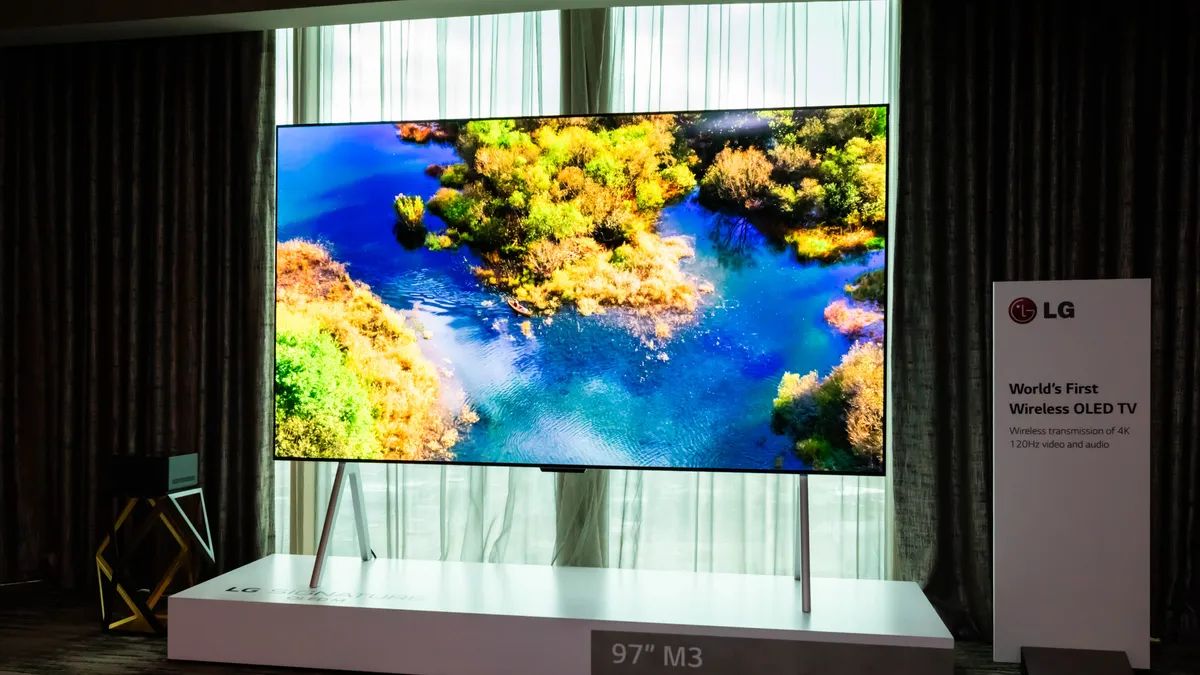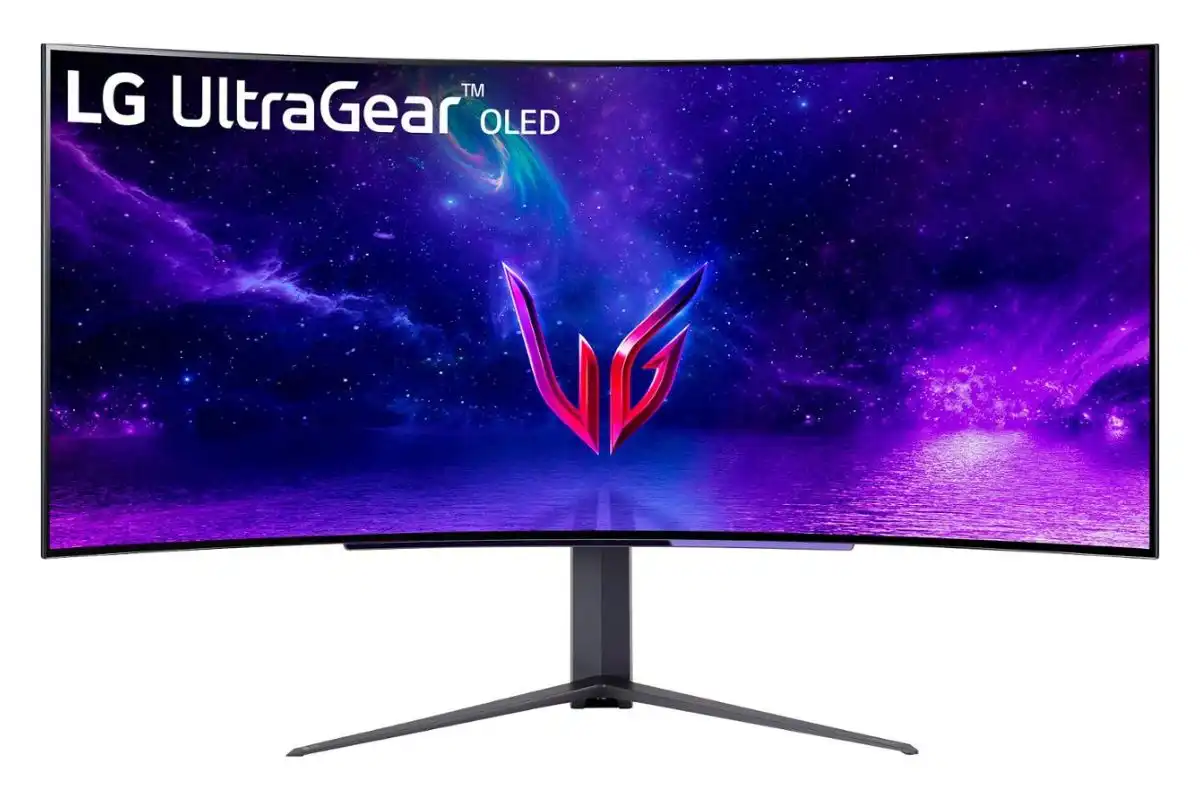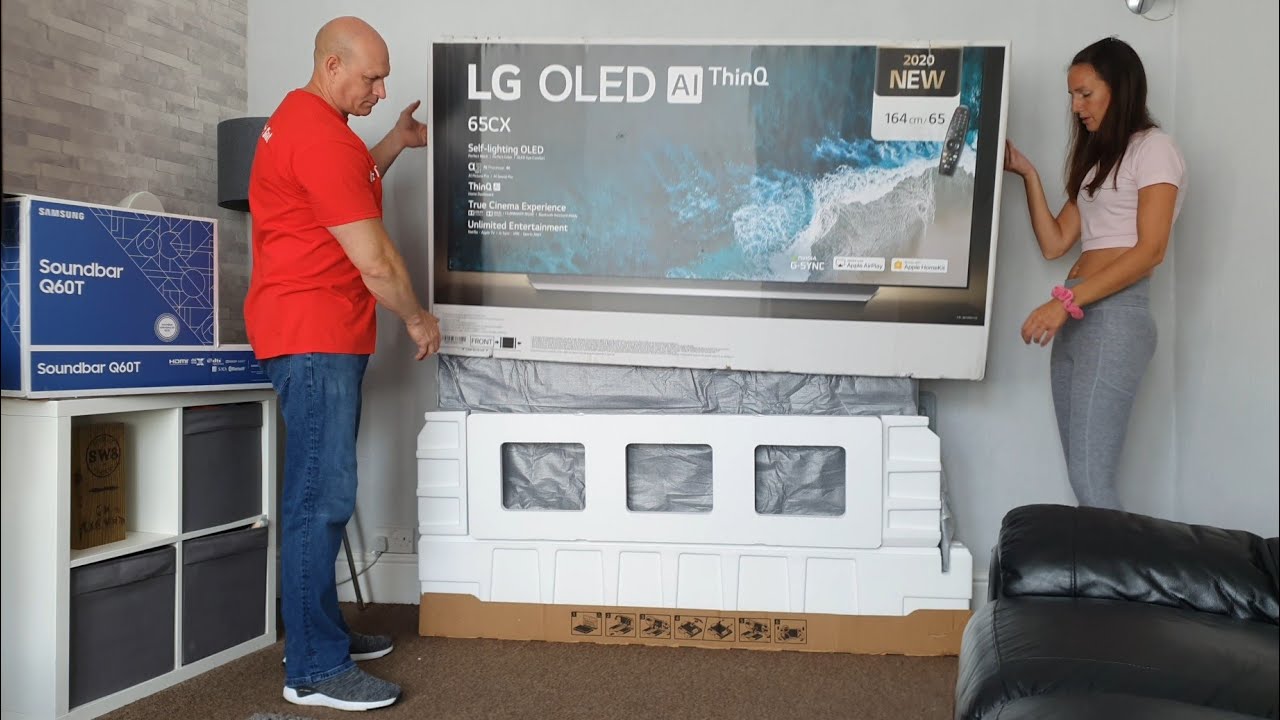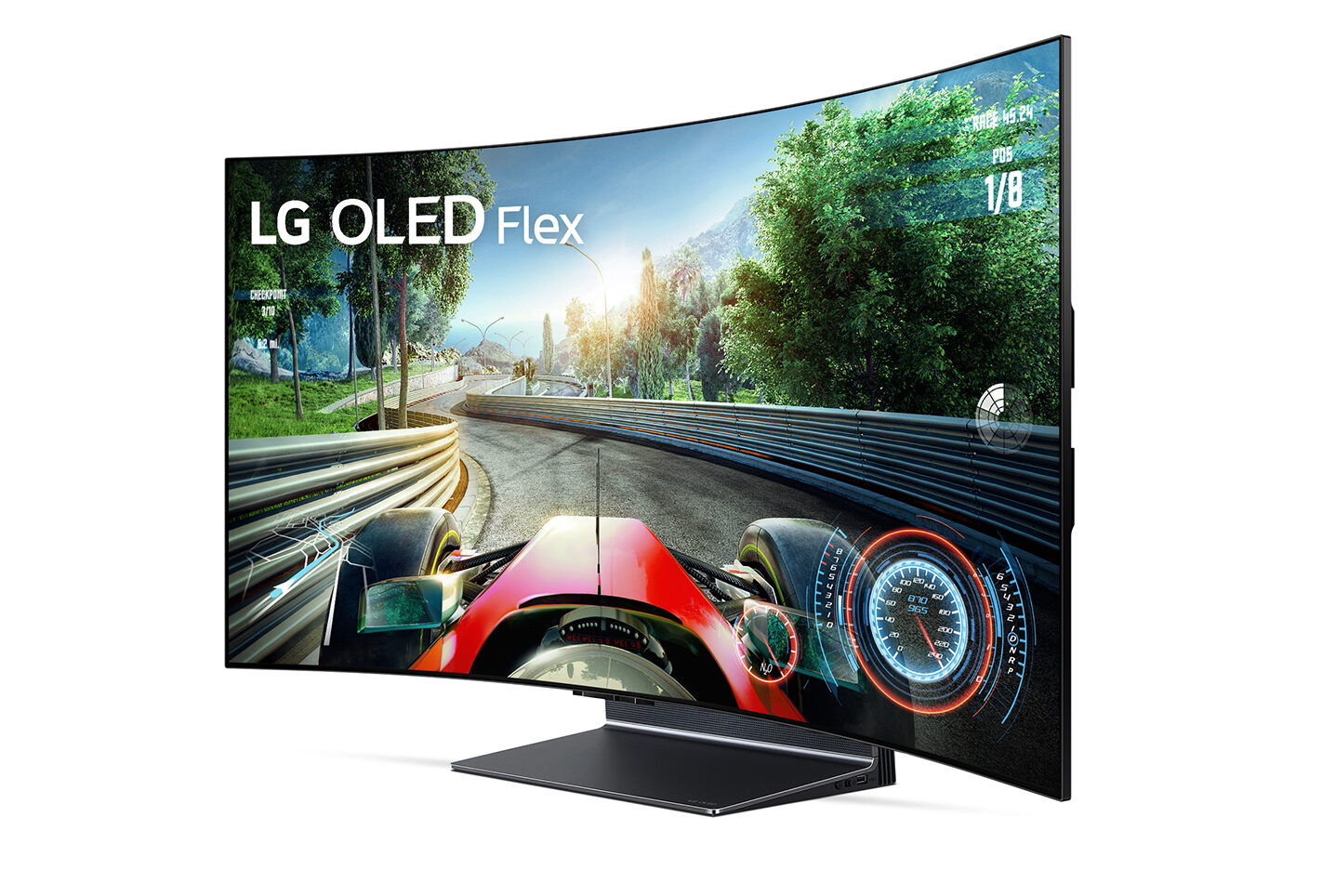Introduction
Welcome to the world of OLED TVs! If you’re considering buying a new television or simply curious about the technology behind these sleek devices, you may have wondered how heavy an OLED TV actually is. While weight might not be the most crucial factor when choosing a TV, it’s still interesting to know the differences between various TV models and why OLED TVs might be lighter or heavier than traditional TVs.
OLED stands for Organic Light-Emitting Diode, and it refers to a specific type of display technology used in modern televisions. Unlike traditional LCD or LED TVs, which rely on backlighting to illuminate the screen, OLED TVs utilize individual organic pixels that emit their own light. This results in superb color accuracy, incredible contrast levels, and near-instantaneous response times.
So, what sets OLED TVs apart from traditional TVs, besides the stunning visual quality? Well, one significant difference lies in their construction, which affects their weight. OLED TVs generally have thinner profiles and more lightweight components compared to their LCD and LED counterparts. However, it’s important to note that the weight of an OLED TV can still vary depending on several different factors.
In this article, we will delve into the factors that contribute to the weight of an OLED TV, such as its size, thickness, materials used, and the type of stand it comes with. Moreover, we will compare the weight of OLED TVs with other types of TVs to give you a better understanding of where they stand in terms of heaviness.
So, if you’re ready to explore the world of OLED TVs and discover what affects their weight, let’s dive in!
What is an OLED TV?
An OLED TV, or Organic Light-Emitting Diode TV, is a type of television that utilizes organic compounds to produce light and create images. In an OLED panel, each pixel is made up of tiny organic materials that emit light when an electric current is applied. This eliminates the need for backlighting, resulting in true blacks, vibrant colors, and exceptional contrast.
OLED technology has gained significant traction in recent years due to its numerous advantages over traditional LCD and LED displays. One of its key strengths is the ability to achieve perfect black levels, as each individual pixel can be turned off completely, resulting in infinite contrast ratios. This adds depth and realism to on-screen images, making OLED TVs a preferred choice for movies, gaming, and other visually immersive experiences.
Another remarkable feature of OLED technology is its wide viewing angles. Traditional LCD displays often suffer from color shifts and loss of contrast when viewed from different angles. However, OLED panels offer consistent picture quality, even when viewed from extreme angles. This makes OLED TVs ideal for large living rooms or when multiple viewers are watching from different positions.
In addition to their stunning picture quality, OLED TVs are also known for their slim design and thin profiles. The individual organic light-emitting diodes are self-illuminating, eliminating the need for a separate backlighting system or complex layering. This results in sleek and modern TV designs that can be thinner and lighter compared to LCD or LED TVs.
Furthermore, OLED technology offers faster response times, which means smoother motion and reduced motion blur. This makes OLED TVs a popular choice for watching fast-paced sports events or playing graphics-intensive video games.
It’s worth mentioning that OLED technology is not limited to televisions. It has also been used in smartphones, tablets, and other handheld devices due to its energy efficiency and excellent color reproduction.
In summary, an OLED TV utilizes organic compounds to emit light and create stunning images, offering advantages such as perfect black levels, wide viewing angles, slim design, fast response times, and energy efficiency. These features combine to provide viewers with an unparalleled visual experience.
How are OLED TVs different from traditional TVs?
OLED TVs are a significant departure from traditional LCD and LED TVs in several key aspects. Understanding these differences can help you make an informed decision when choosing your next television. Here are some of the major contrasts between OLED TVs and traditional TVs:
Display Technology: The most notable difference lies in the display technology used. While traditional LCD and LED TVs rely on backlighting to illuminate the screen, OLED TVs utilize organic pixels that emit their own light. This allows for individual pixel control, resulting in deeper blacks, more vibrant colors, and higher contrast levels.
Picture Quality: OLED technology provides superior picture quality compared to traditional TVs. The self-emitting pixels of an OLED TV allow for precise control over brightness and color accuracy, resulting in richer and more lifelike images. The infinite contrast ratio achieved by OLEDs contributes to exceptional detail and depth in both dark and bright scenes.
Viewing Angles: Traditional LCD displays often suffer from color distortions and loss of contrast when viewed from off-axis angles. However, OLED TVs offer wide viewing angles, allowing viewers to enjoy consistent picture quality from virtually any position in the room. This makes OLED TVs an excellent choice for larger living rooms or when multiple people are watching from different angles.
Design and Thickness: OLED TVs are known for their sleek and slim designs. Unlike traditional TVs, which require a separate backlighting system, OLED TVs have a thin panel that can be as thin as a few millimeters. This slim profile makes OLED TVs aesthetically pleasing and adds a modern touch to any living space.
Response Time: Another advantage of OLED technology is its faster response time compared to traditional TVs. OLED pixels can switch on and off almost instantaneously, resulting in reduced motion blur during fast-paced actions in movies, sports, and video games. This enhances the visual experience and delivers smoother and more fluid motion on the screen.
Energy Efficiency: OLED technology is known for its energy efficiency compared to traditional LCD and LED TVs. This is because OLED pixels only consume power when emitting light. As a result, OLED TVs tend to be more energy-efficient and can help reduce electricity consumption, which is beneficial for the environment and can lead to cost savings on your energy bill.
In summary, OLED TVs differ from traditional TVs in terms of the display technology used, picture quality, viewing angles, design, response time, and energy efficiency. These differences contribute to an enhanced viewing experience, making OLED TVs a popular choice for those seeking stunning visuals and advanced display technology.
Factors that contribute to the weight of an OLED TV
While OLED TVs are generally known for their slim and lightweight designs, there are several factors that contribute to their overall weight. Understanding these factors can help you determine the weight of an OLED TV and compare it to other TV models. Here are the main factors that affect the weight of an OLED TV:
1. Size: The size of the television is a significant factor in determining its weight. Larger OLED TVs with bigger screen sizes will naturally weigh more than smaller ones. This is because larger displays require more materials for the screen, frame, and internal components, which adds to the overall weight of the TV.
2. Thickness: The thickness of an OLED TV also plays a role in its weight. As technology advances, OLED panels are becoming thinner and lighter compared to older models. Thinner TVs generally weigh less because they require fewer materials for the panels and frames. However, it’s worth noting that the weight reduction from thinner panels might not be substantial compared to other factors.
3. Materials used: The materials used in the construction of an OLED TV can affect its weight. Lightweight materials, such as aluminum alloys or carbon fiber, are often used in the frame and stand of OLED TVs to reduce weight without compromising structural integrity. However, premium materials might contribute to a slight increase in weight due to their durability and higher quality.
4. Stand: The type of stand included with the OLED TV can also have an impact on its weight. TVs with sturdy and heavier stands, such as those made of metal or reinforced plastic, will weigh more compared to TVs with simple or lightweight stands. It’s important to consider the weight of the stand when calculating the overall weight of the TV, especially if you plan to mount it on a wall or use a different stand.
5. Additional features: OLED TVs may come with additional features such as built-in speakers, smart functionality, or advanced image processing technologies. These additional components and features can add weight to the TV. While the weight contribution might not be significant, it’s something to consider when comparing the weight of OLED TVs with other models.
Overall, the weight of an OLED TV can vary depending on its size, thickness, materials used, the type of stand it comes with, and any additional features included. It’s important to consider these factors when choosing and handling an OLED TV, especially if you have specific weight limitations or preferences.
The size factor
When it comes to the weight of an OLED TV, one of the most significant factors to consider is its size. The size of the television directly affects its weight as larger displays require more materials for construction and have larger internal components. Let’s explore how the size factor contributes to the weight of an OLED TV.
Generally, OLED TVs are available in a wide range of sizes, from compact models suitable for bedrooms or kitchens to massive displays for dedicated home theaters. It’s important to note that as the screen size increases, so does the weight of the TV.
For example, let’s compare a 55-inch OLED TV with a 75-inch OLED TV. The 55-inch TV might weigh around 40 pounds, while the 75-inch TV could weigh upwards of 80 pounds. This substantial weight difference is primarily due to the larger surface area and increased materials required to construct the larger display.
Why does the size of the TV affect its weight? Well, larger screens necessitate larger OLED panels, more durable frames, and internal components to support the increased display area. The larger size requires more materials, such as glass for the screen, additional metal or plastic for the frame, and extra reinforcement to maintain structural integrity. All these factors contribute to the overall weight of the TV.
It’s also important to consider the practical implications of the size factor when purchasing an OLED TV. Larger TVs can be more challenging to transport and handle due to their increased weight. Mounting a heavy TV on a wall may require additional support or professional assistance. Similarly, moving or repositioning the TV might require multiple people to ensure its safety and prevent any damage.
On the other hand, if you opt for a smaller OLED TV, you can enjoy the benefit of a lighter weight. Smaller OLED TVs are generally more manageable for installation, mounting, and moving around whenever necessary.
In summary, the size of an OLED TV directly influences its weight. Larger screens require more materials and components, resulting in a heavier TV. It’s important to consider the weight implications when choosing the size of your OLED TV and ensure that you have the necessary support and resources to handle and install it properly.
The thickness factor
When considering the weight of an OLED TV, another critical factor to take into account is its thickness. The thickness of an OLED TV can contribute to its overall weight, although the impact may vary depending on other factors. Let’s explore how the thickness factor can affect the weight of an OLED TV.
As technology advances, OLED TVs have become increasingly thinner compared to earlier models. Thinness has become a sought-after feature in modern televisions, as it allows for a sleek and visually appealing design. OLED technology, with its self-emissive pixels, enables TVs to have slim profiles that can be as thin as a few millimeters.
While thinner OLED panels result in a more lightweight TV, the weight reduction might not be significant compared to other factors such as size or materials used. This is because the overall weight of the TV is not solely determined by the thickness of the panel, but also by other components and materials used in the construction.
Thin OLED panels require fewer materials compared to thicker panels. Manufacturers can use lighter materials for the panel itself, such as flexible plastic substrates, instead of rigid glass. This reduction in material weight contributes to a lighter TV overall.
However, it’s important to note that the weight savings achieved through thinner panels might be offset by other factors. For example, the frame and stand of the TV still need to be sturdy and durable to support the screen. These components may require additional materials to compensate for the reduced thickness of the panel, resulting in a similar overall weight compared to thicker TVs.
Additionally, the increased use of premium materials, such as aluminum alloys or carbon fiber, in the frame and stand, can add a slight weight increase despite the thinner panel. These materials are often chosen for their strength and durability, contributing to a high-quality TV build.
In summary, the thickness of an OLED TV can impact its weight, but the weight reduction from a thinner panel might not be significant compared to other factors. While thin panels require fewer materials and can contribute to a lighter TV, the overall weight is still influenced by the frame, stand, and materials used. It’s important to consider the overall weight of the TV and not solely rely on the thickness of the panel when making a purchasing decision.
The materials used factor
When it comes to the weight of an OLED TV, the materials used in its construction play a crucial role. The choice of materials can affect the overall weight of the TV, as well as its durability and aesthetic appeal. Let’s explore how the materials used factor contributes to the weight of an OLED TV.
OLED TVs are designed to be slim and lightweight, and manufacturers carefully choose materials that can achieve these goals without compromising structural integrity.
Panel Materials: The panel itself is typically made of either glass or flexible plastic substrates. Glass panels offer a premium look and provide excellent protection for the OLED display. However, glass can be relatively heavier compared to flexible plastic, which is lighter and more resistant to breakage. Manufacturers often decide on the type of substrate based on the specific design and weight considerations of the TV.
Frame Materials: The frame of an OLED TV is responsible for holding the panel and other components together. Common materials used for the frame include aluminum, aluminum alloys, or high-quality plastics. These materials offer a balance between durability, lightweight construction, and aesthetic appeal. Aluminum alloys, in particular, are known for their strength-to-weight ratio and are often used in premium OLED TVs.
Stand Materials: The stand of an OLED TV is essential for stability and viewing comfort. Stands can be made of metal, plastic, or a combination of the two. Metal stands, such as those made from aluminum or steel, provide excellent strength and stability but may contribute to a slightly higher overall weight. On the other hand, stands made from high-quality plastic can offer durability while keeping the weight of the TV relatively low.
Additional Components: OLED TVs may also have additional components that impact their weight. These include built-in speakers, circuit boards, power supplies, and smart TV functionalities. The materials used for these components can vary, but manufacturers aim to use lightweight materials without compromising performance.
It’s worth noting that the choice of materials not only affects the weight of the TV but also its quality and overall aesthetic appeal. Premium materials, such as aluminum alloys or carbon fiber, might contribute to a slightly higher weight, but they can offer enhanced durability, structural rigidity, and a more luxurious look.
In summary, the materials used factor is an essential consideration when it comes to the weight of an OLED TV. The choice of materials for the panel, frame, stand, and additional components can impact the overall weight of the TV, as well as its durability and aesthetic appeal. Manufacturers carefully select materials that strike a balance between lightweight construction, strength, and visual appeal to deliver a high-quality OLED TV experience.
The stand factor
When examining the weight of an OLED TV, one crucial factor to consider is the type of stand that comes with it. The stand not only provides stability and support for the TV but can also contribute to its overall weight. Various factors related to the stand can impact the weight of an OLED TV. Let’s delve into the stand factor and understand its influence.
Stand Material: The material used for the stand can significantly affect the weight of the TV. Stands are commonly made of metal, reinforced plastic, or a combination of both. Metal stands, such as those constructed with aluminum or steel, offer excellent stability and durability but can contribute to a higher overall weight. On the other hand, stands made from high-quality plastic materials can provide a balance between strength and a lighter weight.
Stand Design: The design of the stand can also affect the weight of the TV. The complexity of the stand’s structure, including its shape, size, and additional features, can add weight. Stands with adjustable features or built-in cable management systems, for example, might utilize more materials and contribute to a slightly increased weight.
Stability and Safety: The stand’s primary purpose is to provide stability to the TV, ensuring that it remains securely in place. The materials and design of the stand are optimized to prevent wobbling or tipping over of the TV. Sturdy stands that offer a high degree of stability may have additional reinforcements or thicker structural components, which can result in a slightly heavier weight.
Flexibility and Adjustability: Some stands are designed to allow for various viewing angles or even swivel capabilities. Stands with these flexibility features might have more complex mechanisms or additional parts, contributing to a marginally increased weight. However, it’s important to note that the weight variation from these features is typically minimal and may not significantly impact the overall weight of the TV.
It’s worth mentioning that the weight of the stand itself should be evaluated separately from the weight of the TV. While the stand does contribute to the overall weight when the TV is placed on it, it can be detached if you decide to wall-mount the television or use a different type of stand or mounting solution.
Considering personal preferences and requirements, it’s essential to choose a stand that suits your needs. Whether you prioritize stability, adjustability, or simplicity, understanding the impact of the stand on the weight of the TV can aid in your decision-making process.
In summary, the type of stand that comes with an OLED TV can influence its weight. Factors such as the stand’s material, design, stability, and additional features can contribute to the overall weight of the TV. While the weight of the stand should be taken into account, it can be detached or replaced based on individual preferences and mounting options.
Comparing the weight of OLED TVs with other types of TVs
When it comes to the weight of televisions, OLED TVs generally offer a distinct advantage over other types of TVs, such as LCD and LED models. The sleek and lightweight design of OLED TVs is often one of their appealing features. Let’s compare the weight of OLED TVs with other types of TVs to understand the differences.
LCD TVs: LCD TVs, which utilize liquid crystal displays, tend to be heavier compared to OLED TVs. This is primarily due to the presence of a backlighting system, which requires additional layers and materials. The backlighting system illuminates the LCD panel, resulting in extra weight. Consequently, LCD TVs can weigh more than their OLED counterparts of similar sizes.
LED TVs: LED TVs are a type of LCD TVs that use light-emitting diodes (LEDs) for backlighting. Like LCD TVs, LED TVs tend to be heavier than OLED TVs due to the presence of a backlighting system. However, advances in LED technology have resulted in thinner and lighter LED TVs compared to older LCD models. Despite the weight reduction, OLED TVs generally still have an edge in terms of slimness and overall weight.
Plasma TVs: Plasma TVs are a now-discontinued type of television that used gas plasma cells to create an image. These TVs were known for their bulky designs and relatively higher weight. Due to the technology involved, plasma TVs were often heavier than both LCD and OLED TVs, making them less suitable for wall-mounting or portable installations.
It’s important to note that the weight of a TV can vary significantly based on factors such as size, individual model, and specific features. While OLED TVs are usually lighter compared to other types, there may still be variation within the OLED TV category itself.
Additionally, it’s crucial to consider that a TV’s weight should not be the sole determining factor when making a purchasing decision. Factors such as picture quality, display technology, viewing experience, and features also play a significant role in determining which TV is the best fit for your needs.
In summary, OLED TVs generally offer a lightweight and slim design, making them lighter compared to other types of TVs such as LCD, LED, and plasma models. However, it’s essential to consider the specific model, size, and features of the TV as weight can still vary within the OLED TV category itself. When choosing a TV, consider the weight in conjunction with other important factors to make an informed decision.
Conclusion
In conclusion, the weight of an OLED TV is influenced by several key factors, including its size, thickness, materials used, and the type of stand it comes with. Understanding these factors can help you make an informed decision when selecting an OLED TV and comparing it to other types of televisions.
OLED TVs are known for their slim and lightweight designs, thanks to the use of organic light-emitting diodes that eliminate the need for a separate backlighting system. This results in TVs that are thinner and lighter compared to traditional LCD and LED models.
The size of an OLED TV directly impacts its weight, with larger screens requiring more materials for construction and larger internal components. The thickness of an OLED TV can also affect its weight, although the overall reduction in weight due to thin panels might not be substantial compared to other factors.
Materials used in the construction of an OLED TV, such as the panel, frame, and stand, can contribute to its weight. Lightweight materials like aluminum alloys or high-quality plastics are often used to balance weight and structural integrity.
The type of stand that comes with an OLED TV can also influence its weight. Stands made from metal or reinforced plastic may add to the overall weight but provide excellent stability and durability.
When compared with other types of TVs, such as LCD, LED, and plasma models, OLED TVs generally offer a lighter and more streamlined design. However, it’s essential to consider specific models, sizes, and features within the OLED TV category, as weight can still vary.
In your search for the perfect TV, while weight is an important consideration, it should not be the sole determining factor. Other factors such as picture quality, display technology, viewing experience, and additional features should also be taken into account to ensure that you select a TV that meets your needs and preferences.
By understanding the various factors that contribute to the weight of an OLED TV, you can make a well-informed decision and find the perfect balance between aesthetics, performance, and convenience.
























